
The Pieridae are a large family of butterflies with about 76 genera containing about 1,100 species, mostly from tropical Africa and tropical Asia with some varieties in the more northern regions of North America and Eurasia. Most pierid butterflies are white, yellow, or orange in coloration, often with black spots. The pigments that give the distinct coloring to these butterflies are derived from waste products in the body and are a characteristic of this family. The family was created by William John Swainson in 1820.
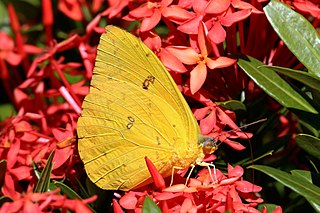
Phoebis sennae, the cloudless sulphur, is a mid-sized butterfly in the family Pieridae found in the Americas. There are several similar species such as the yellow angled-sulphur, which has angled wings, statira sulphur, and other sulphurs, which are much smaller. The species name comes from the genus Senna to which many of the larval host plants belong.

Gonepteryx rhamni, commonly named the common brimstone, is a butterfly of the family Pieridae. It lives throughout the Palearctic zone and is commonly found across Europe, Asia, and North Africa. Across much of its range, it is the only species of its genus, and is therefore simply known locally as the brimstone. Its wing span size is 60–74 mm (2.4–2.9 in). It should not be confused with the brimstone moth Opisthograptis luteolata.
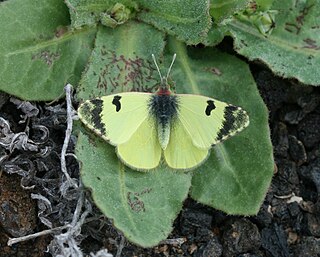
Euchloe charlonia, the greenish black-tip or lemon white, is a butterfly in the family Pieridae. Its range is mainly in northern Africa, the Middle East and occasionally the southern Iberian Peninsula, especially Spain.

Dismorphiinae, the mimic sulphurs, is a subfamily of butterflies from the family Pieridae. It consists of about 100 species in seven genera, distributed mainly in the Neotropical region, of which only one species occurs in North America and one genus, Leptidea, is in the Palaeartic region.

Aporia leucodice, the Himalayan blackvein, is a mid-sized to large butterfly of the family Pieridae, that is, the yellows and whites, which is found in India.

Eurema andersonii, the one-spot grass yellow or Anderson's grass yellow, is a small butterfly of the family Pieridae, that is, the yellows and whites, which is found in India, Myanmar and other parts of Asia.
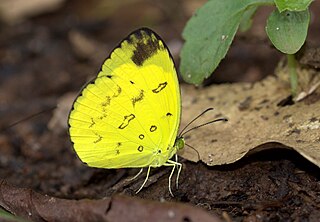
Eurema nilgiriensis, the Nilgiri grass yellow, is a small butterfly of the family Pieridae, that is, the yellows and whites, which is found in south India.

Gonepteryx mahaguru, the lesser brimstone, is a medium-sized butterfly of the family Pieridae, that is, the yellows and whites. It is native to the Kashmir, Uttarakhand, China, Korea, and Japan.
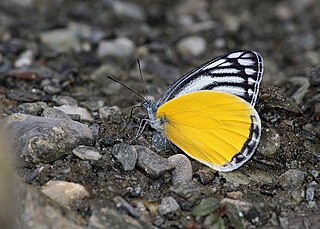
Delias agostina, the yellow Jezebel is a medium-sized butterfly of the family Pieridae, that is, the yellows and whites.

Delias sanaca, the pale Jezebel, is a medium-sized butterfly of the family Pieridae. The species was first described by Frederic Moore in 1857.

Colias stoliczkana, the orange clouded yellow, is a small butterfly of the family Pieridae, that is, the yellows and whites, that is found in India.
Butterfly evolution is the origin and diversification of butterflies through geologic time and over a large portion of the Earth's surface. The earliest known butterfly fossils are from the mid Eocene epoch, between 40-50 million years ago. Their development is closely linked to the evolution of flowering plants, since both adult butterflies and caterpillars feed on flowering plants. Of the 220,000 species of Lepidoptera, about 45,000 species are butterflies, which probably evolved from moths. Butterflies are found throughout the world, except in Antarctica, and are especially numerous in the tropics; they fall into eight different families.
Harish (Honnayya) S. Gaonkar is an Indian specialist on butterflies who contributed to the Zoological Museum at the University of Copenhagen, Denmark and wrote a 1996 compilation of butterflies of Western Ghats, South India cataloguing 330 species. Gaonkar earned his PhD from the University of California, Berkeley.

Anteos clorinde, the white angled-sulphur or the ghost brimstone, is a butterfly of the family Pieridae. The species was originally described by Jean-Baptiste Godart in 1824.
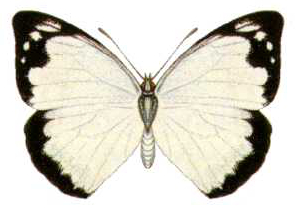
Appias paulina, the common albatross, Christmas Island white or Ceylon lesser albatross, is a butterfly of the family Pieridae. It is found from India to Samoa, including Indonesia, Japan, Malaysia, New Caledonia, Sri Lanka, Thailand and Australia.

Catopsilia florella, the African migrant, African emigrant, or common vagrant, is a butterfly of the family Pieridae. It is found in Africa, Arabia and the Canary Islands. Like Catopsilia pomona, this species also has a habit of migration.Many early authors mentioned the presence of this species in Asia; but those were probably due to confusion arises as Catopsilia pyranthe females exhibit a lot of seasonal variations. Catopsilia florella is not included as a species in India in any recent checklists.
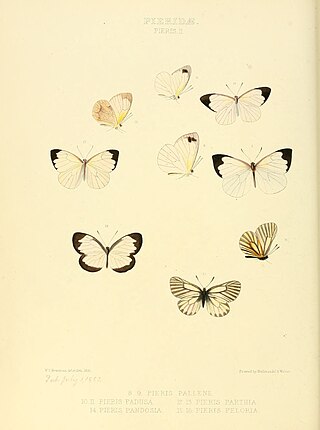
Mesapia is a genus of butterflies in the family Pieridae. It contains only one species, Mesapia peloria, the Tibet blackvein, which is found in India, Nepal and China. It is a mid-sized to large species.
















